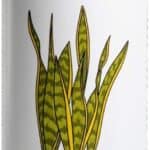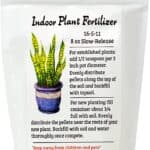Indeed, Snake Plants are probably one of the low-maintenance household plants. But requires a timely dose of feed.
And, if you are in a dilemma about understanding the plant’s nutrient requirement, this article is for you.
Table of Contents Show
Best Time to Fertilize Snake Plants
To reap the maximum benefits from a plant, feed the plant during the growing season.
Not only does the plant’s overall activity exhilarates, but fertilizer help boosts the growth.
However, irrational feed application other than the growth period does no good to the plant.
In other words, adding fertilizer at the end of the growing season won’t help much. Instead, overfertilization risk persists.
Signs Your Snake Plant Needs Fertilizers
Snake Plants delivers signs of distress through their physical attribute when nutrients are required. So keep a close eye on your plant.
- The cessation of the plant’s growth, even in the growing season.
- Weakening of the root system of the Snake Plant.
- Absence of variegation (i.e., two-toned or multi-toned parts of the plant).
- The presence of droopy and curled leaves.
- Edges of the leaves turn yellow and brown.
- Presence of random spots on the leaves, followed by discoloration.
How Often should you Fertilize Your Snake Plant?
Apart from the growing seasons, the size of the pot, fertilizer type, and the plant’s placement equally contribute to the frequency and amount of feed provided to the plant.

Larger pots have higher water retention and require more nutrients for the plant to grow.
Similarly, fertilizers in the granular form are the most effective for slow release.
And, while using granular fertilizer, it is better to fertilize the plant twice in each growing season. This is because granular fertilizer is most effective for slowly releasing nutrients in the soil over time.
Snake Plants that receive more light require more fertilizer. Whereas Snake Plants that receive poor light intensity do not have enough energy, there is less fertilizer use.
Best Fertilizer to Use for Snake Plant
It’s natural for a newbie to become overwhelmed by the variety of fertilizers available.
Let’s walk through the basics of the fertilizer required for your Snake Plant.
NPK, Macro and Micro Nutirent
Nitrogen, Phosphorus, and Potassium are three fundamental elements required for the well-being and development of any plant, including the Snake Plant.
The best fertilizer for Snake Plants is usually that with a balanced ratio of NPK, either 10:10:10 or 5:10:10.
But, the growth and proper of the plant do not depend on these three elements only.
The micronutrients [Boron (B), Zinc (Zn), Manganese (Mn), Iron (Fe), Copper (Cu), Molybdenum (Mo), and Chlorine (Cl)] are seven important plant nutrients.
However, they make up less than 1% of the dry weight of most plants.
Micronutrients are those nutrients that the plant consumes in small amounts.
Therefore, the amount of these micronutrients in fertilizers is modest since the plant only requires small amounts.
On the other hand, these micronutrients aid in processing macronutrients so plants can absorb them.
Similarly, macronutrients (those required in large quantities) are primarily responsible for plant development and growth.
| Nutrients | Functions |
|---|---|
| Nitrogen | It helps to form protein, stimulates growth and encourage photosynthesis. |
| Phosphorus | It helps in optimization of plant energy, encourages root growth and cellular division. |
| Potassium | It improves the immune system and overall quality of the plant. |
| Calcium | It maintains the pH of soil, strengthen the cell wall and improves nutrient absorbing capacity. |
| Sulphur | It is important for synthesis of amino acids and to adapt well in winter. |
| Magnesium | It is essential for photosynthesis. |
Type of Fertilizer to Use for the Snake Plant
- Granular Fertilizer: Dry slow-release fertilizers in the shape of granules or tiny lumps are available. Because of their granular structure, these fertilizers take longer to break down in the soil, requiring more time for your Snake Plant to absorb.
- Liquid Fertilizer: Liquid fertilizers act quickly and are available in liquid form. It can be applied straight to the soil or blended with filtered water. Snake Plants easily absorb liquid fertilizers in a short amount of time.
- Foliar Fertilizer: A dilute fertilizer that you may spray straight on your Snake Plant’s leaves, where your plant absorbs the vital nutrients. Foliar fertilizers act swiftly.
Although sticks and granular fertilizers seem convenient, they do not thoroughly distribute the soil’s nutrients. And you have no control over how they dispatch the nutrients.
So, liquid or slow-release fertilizer is most suitable as Snake Plants are mainly adorned indoors, and it’s easy to keep track of the nutrients supplied.
Top 5 Best Fertilizers for Snake Plant
The market has a spread of fertilizers varieties for you to choose from, and each one claims to be the best.
As a plant parent, understanding your plant’s needs should be the priority, and you should act accordingly.
Moreover, here are some of the fertilizers we recommend for your Snake Plant.
| Fertilizers | Features | Image |
|---|---|---|
| Perfect Plants Liquid Snake Plant Fertilizer | 1. Revitalizing the sick snake plant 2. Specially formulated for Snake Plant 3. Used for other indoor succulents too |  |
| Indoor Plant Food (Slow-Release Pellets) | 1. NPK ratio 16:5:11 2. Strengthen the leaves to stand upright 3. Pellets for even distribution |  |
| Lilly Miller All Purpose Planting And Growing Food | 1. Fast-acting ingredients 2. Fortified with essential plant nutrients 3. Promotes steady growth 4. No assembly required |  |
| Jobe's Houseplant Indoor Fertilizer Food Spikes | 1. Easy handling and storage 2. Slow-release formula lasts all season 3. Supply nutrients to the root zone |  |
| Espoma Organic Indoor Plant Food | 1. Easy-to-use 2. Fast result 3. Safe to use around kids and pets. |  |
How to Fertilize Snake Plant Properly?
There are different methods of fertilizer application according to the fertilizer we use.
For granular formulations, take the recommended amount of granules and spread them uniformly on the soil surface.
Do not forget to water the plant because they will release nutrients every time you water.
Similarly, to use liquid fertilizer, you’ll need a watering can and measuring cup before you begin the process.
Further, add about 1/4th teaspoon or around 1ml of liquid fertilizer into a gallon of water.
Last but not least, ensure you water your Snake Plant after fertilization and empty the saucer beneath the pot after the water drains out.
Tips On Fertilizing Snake Plant
Out of love, we, plant parents, sometimes tend to overwhelm the plant with excess fertilizer at random intervals.
But a little mindfulness is important for happily thriving plants.
Additionally, you use homemade organic or natural fertilizers like manures, bonemeal, and coffee grounds to help improve the blooming Snake plants.

What Would Too Much Fertilizer Do to Your Snake Plant?
Native to the desert regions, rocky soil and a minimum dose of fertilizer is all your Snake Plant long for.
Excess feed causes chemical burns in the root zone of the plant. The compacted crust on the pot is the first symptom of root burn with gradual browning of edges and tips of leaves.
This further elevates into the yellowing of the entire plant’s leaves and ultimately costs the plant’s life.
Immediate Steps of Revival
- Place the plant in the sink.
- Run water through the plant and repeat the process multiple times (four to five times) between certain intervals until the salt and chemical flush out.
- Allow the plant to drain well between watering intervals to prevent overwatering issues.
Switching your watering method in between is recommended if you follow the bottom watering technique for your plants to avoid salt and chemical accumulation.
From Editorial Team
Conclusion!
Fertilizer in Snake Plants is uncommon, for it is very resilient and flexible.
With a little timely feed, you could get lucky to witness your Snake Plant bloom and bear flowers.
However, the fertilizer requirements are similar for other plants such as Philodendron, Cactus, Pothos, and Palms.
